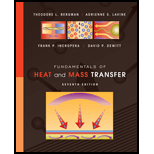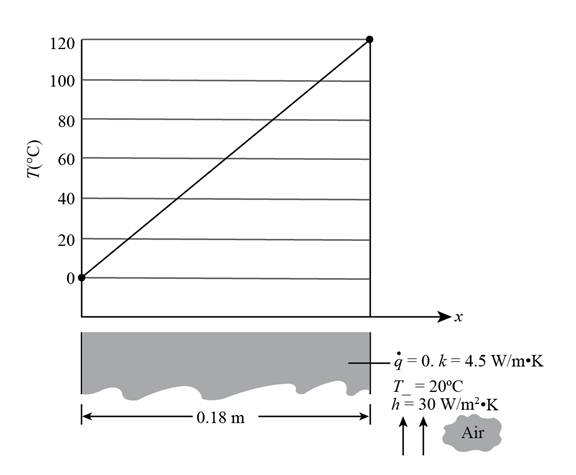
Concept explainers
(a)
Whether the prescribed temperature distribution possible or not along with an explanation.
The temperature distribution is not possible as the conduction and convection heat transfer is not possible.
Given:
The given diagram is shown in Figure 1.

Figure 1
The thermal conductivity of the wall is
The steady state temperature of the wall is
The thickness of the wall is
The convection heat transfer of the wall is
Formula Used:
The expression for the energy balance equation for the steady flow is given by,
The expression for the conduction heat transfer per unit area is given by,
Here,
The expression for the convection heat transfer per unit area is given by,
Calculation:
The conduction heat transfer per unit area is calculated as,
The convection heat transfer per unit area is calculated as,
The energy balance equation is calculated as,
The temperature distribution is not possible as the value of conduction and convection heat transfer is not equal.
Conclusion:
Therefore, the temperature distribution is not possible as the conduction and convection heat transfer is not possible.
(b)
The computation and the plot of the temperature at
Want to see the full answer?
Check out a sample textbook solution
Chapter 2 Solutions
Fundamentals of Heat and Mass Transfer
- A plane wall 15 cm thick has a thermal conductivity given by the relation k=2.0+0.0005T[W/mK] where T is in kelvin. If one surface of this wall is maintained at 150C and the other at 50C, determine the rate of heat transfer per square meter. Sketch the temperature distribution through the wall.arrow_forwardA plane wall of thickness 2L has internal heat sources whose strength varies according to qG=qocos(ax) Where qo is the heat generated per unit volume at the center of the wall (x=0) and a is a constant. If both sides of the wall are maintained at a constant temperature of Tw, derive an expression for the total heat loss from the wall per unit surface area.arrow_forwardA plane wall of thickness 8cm and thermal conductivity k=5W/mK experiences uniform volumetric heat generation, while convection heat transfer occurs at both of its surfaces (x= -L, x= + L), each of which is exposed to a fluid of temperature T∞ = 20˚C. The origin of the x-coordinate is at the midplane of the wall. Under steady-state conditions, the temperature distribution in the wall is of the form T(˚C) = a + bx - cx^2, where x is in meters, a =86˚C, b = -500˚C/m, and c=4459. 1) Heat Flux Entering the wall is ? 2) Temperature at the left face is /arrow_forward
- Find the two-dimensional temperature distribution T(x,y) and midplane temperature T(B/2,W/2) under steady state condition. The density, conductivity and specific heat of the material are p=(1200*32)kg/mº, k=400 W/m.K, and cp=2500 J/kg.K, respectively. A uniform heat flux 9" =1000 W/m² is applied to the upper surface. The right and left surfaces are also kept at 0°C. Bottom surface is insulated. 9" (W/m) T=0°C T=0°C W=(10*32)cm B=(30*32)cmarrow_forwardFind the two-dimensional temperature distribution T(x,y) and midplane temperature T(B/2,W/2) under steady state condition. The density, conductivity and specific heat of the material are ρ =1200 kg/m 3, k=400 W/m.K, and cp=2500 J/kg.K, respectively. A uniform heat flux q =1000 W/m 2 is applied to the upper surface. The right and left surfaces are also kept at 0oC. Bottom surface is insulated.arrow_forwardThe heat flow per unit length of a thick cylindrical pipe is 772 W per meter. The pipe has radii ri = 12 cm, ro = 24 cm, outside surface temperature, To = 95 deg C and k = 0.05 + 0.0008T where T is in deg C and k is in W/(m K). Find the inside surface temperature of the pipe, assuming steady state conditions and accounting for the variation of thermal conductivity with temperature. Also determine the temperature of a point midway to the inside and outside radius.arrow_forward
- 4x F2 # 3 E 4, F3 54 $ R F4 Ac = 1m² ▬ H DII x= 1 m (4) Consider a wall (as shown above) of thickness L-1 m and thermal conductivity k-1 W/m-K. The left (x=0) and the right (x=1 m) surfaces of the wall are subject to convection with a convectional heat transfer coefficient h= 1 W/m²K and an ambient temperature T. 1 K. There is no heat generation inside the wall. You may assume 1-D heat transfer, steady state condition, and neglect any thermal contact resistance. Find T(x). % To,1 = 1 K h₁ = 1 W/m²K 5 Q Search F5 T T₁ A 6 x=0 F6 à = 0 W/m³ k= 1W/mK L=1m Y 994 F7 & 7 T₂ U Ton2 = 1 K h₂ = 1 W/m²K1 PrtScn F8 Page of 7 ) 0 PgUp F11 Parrow_forwardThe initial temperature distribution of a 5 cm long stick is given by the following function. The circumference of the rod in question is completely insulated, but both ends are kept at a temperature of 0 °C. Obtain the heat conduction along the rod as a function of time and position ? (x = 1.752 cm²/s for the bar in question) 100 A) T(x1) = 1 Sin ().e(-1,752 (³¹)+(sin().e (-1,752 (²) ₁ + 1 3π TC3 .....) 100 t + ··· ....... 13) T(x,t) = 200 Sin ().e(-1,752 (²t) + (sin (3). e (-1,752 (7) ²) t B) 3/3 t + …............) C) T(x.t) = 200 Sin ().e(-1,752 (²t) (sin().e(-1,752 (7) ²) t – D) T(x,t) = 200 Sin ().e(-1,752 (²)-(sin().e (-1,752 (²7) ²) t E) T(x.t)=(Sin().e(-1,752 (²t)-(sin().e(-1,752 (²) t+ t + ··· .........) t +.... t + ··· .........) …..)arrow_forwardContinuous temperature distribution in a semi-permeable material with laser radiation on it, thickness L and with a heat conduction coefficient k, T(x)=-A/k.a^2.e^-ax+Bx+C It is given by equality. Here A, a, B and C are known constants. For this case, the radiation absorption in the material manifests itself in a uniform heat generation term in the form q (x). a) Obtain a relationship for the type that gives the conduction heat fluxes on the front and back surfaces. b) get a correlation for q(x) c) Obtain a relation that gives the radiation energy produced per unit surface area in the whole material.arrow_forward
- (Q4) A 4m x 6m wall consists of 4 glass windows of 2m x 1.5m dimensions. The wall has thickness of 0.13m and a thermal conductivity of 0.5 W/m.K, while the glass windows are 6 mm thick with a thermal conductivity of 1.228 W/m.K. The values of intemal and external surface conductance for the wall (including glass) are 7.8 W/m? K and 34.4 W/m².K, respectively. The intemal and extemal temperatures are 22° C and 42°C, respectively. Calculate the total heat transfer rate through the wall. What percentage of this heat transfer is through the windows?arrow_forwardA plane wall of thickness 2L = 30 mm and thermal conductivity k = 7 W/m-K experiences uniform volumetric heat generation at a rate q, while convection heat transfer occurs at both of its surfaces (x = − L, + L), each of which is exposed to a fluid of temperature T = 20°C. Under steady-state conditions, the temperature distribution in the wall is of the form T(x) = a + bx + cx² where a = 82.0°C, b = -210°C/m, c = -2x 10°C/m², and x is in meters. The origin of the x-coordinate is at the midplane of the wall. (a) What is the volumetric rate à of heat generation in the wall? (b) Determine the surface heat fluxes, q" (L)and q ( + L). (c) What are the convection coefficients for the surfaces at x = - Land x = + L? The volumetric rate of heat generation in the wall, in W/m³: q = i W/m³ The surface heat flux, in W/m²: qx ( - L) = i The surface heat flux, in W/m²: q (+ L) = i W/m² W/m² The convection coefficients for the surface at x = - L, in W/m²-K: h(- L) = i W/m².K The convection…arrow_forward3.10 By neglecting lateral temperature variation in the analysis of fins, h,T. 木 H two-dimensional conduction is modeled as a one-dimensional H problem. То examine this T, h,T. approximation, consider a semi- infinite plate of thickness 2H. The base is maintained at uniform temperature T,. The plate exchanges heat by convection at its semi- infinite surfaces. The heat transfer coefficient is h and the ambient temperature is T.. Determine the heat transfer rate at the base.arrow_forward
 Principles of Heat Transfer (Activate Learning wi...Mechanical EngineeringISBN:9781305387102Author:Kreith, Frank; Manglik, Raj M.Publisher:Cengage Learning
Principles of Heat Transfer (Activate Learning wi...Mechanical EngineeringISBN:9781305387102Author:Kreith, Frank; Manglik, Raj M.Publisher:Cengage Learning
